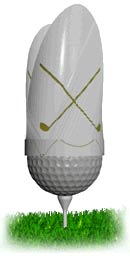|




|
Walking the Links is Good Exercise -- if It's Allowed
Health Benefits Aside, Many Golf Courses Require Players to Rent Carts
Therese Droste, � 2001 The Washington Post Company
Washington Post, Health Section Tuesday, May 15, 2001; Page HE06 Walk or ride? It's a perpetual fairway dilemma, right up there with whether you should permit mulligans. Healthwise, walking is far superior: On foot, a four-hour, 18-hole round of golf burns about 1,200 calories, says Patty Freedson, an exercise physiologist and professor in the science department at the University of Massachusetts, Amherst. And Finnish researchers reported last year that walking the links burns fat and boosts HDL, or good cholesterol. Even the United States Golf Association (USGA), the sport's national governing body, views walking as integral to the game.
But for those in the business of moving players over the links, integral sometimes takes a back seat to profitable. "Golf carts generate revenue for clubs. And we prefer people to ride [carts] because we can monitor play to make sure no one sneaks on to the golf course," says Bob Robinson, golf pro at the semiprivate South Riding Golfers Club near Dulles. A recent survey shows that municipal courses are the best bets for those wanting to hoof the links; roughly half of the public facilities included in this National Golf Foundation study don't require carts. In the Washington area, public courses like the one in Rock Creek Park generally let players choose between feet and seat -- even on busy weekend mornings, when most other courses insist on cart rental. At Augustine Golf Club, a semiprivate course in Stafford, Va., cart use is optional, but the rental fee is not. "We allow walking, but people seem to be cart-driven," says Roger Wolfe, manager of golf operations.
Cart fees in the Washington area range between $15 and $30 per person, with two players generally sharing a single cart. "It can be a money-making factory," admits former USGA executive Dean Knuth. For older and disabled players -- like Casey Martin, a touring professional who has a rare circulatory condition that makes walking difficult -- carts are a boon, of course. (A U.S. Supreme Court ruling is pending in PGA Tour v. Martin, in which the association of touring pros seeks to ban the use of golf carts in its competitions.)
Do carts really speed up play? Knuth -- known as "the Pope of Slope" for devising a system that adjusts a golfer's handicap to any given course's difficulty -- says no. Carts, he says, "are equal [in speed] to walking if they're allowed on the fairways. But when carts are restricted to golf paths, they slow down play considerably, adding 11 percent to the total time played to a round of golf." Plus, there's the health factor: "The bad thing about carts is that you don't get as much exercise when you ride one."
Some intrepid golfers don't let mandatory cart policies interfere with their constitutionals. When a cart's required, Freedson makes her partner drive while she walks. "But if my partner likes to walk, then we negotiate a bit and switch off the driving," she says.
|




